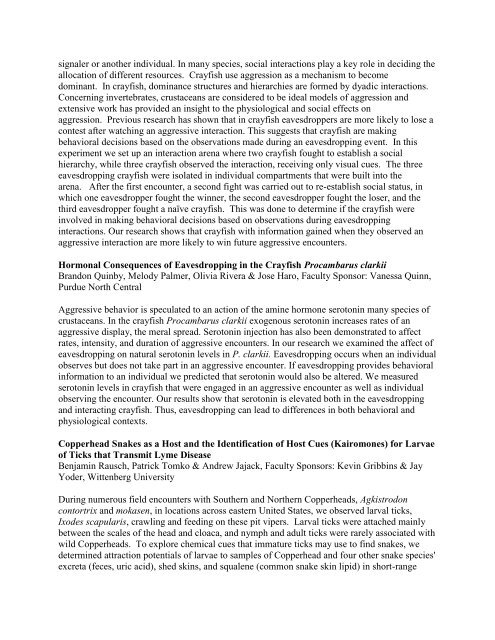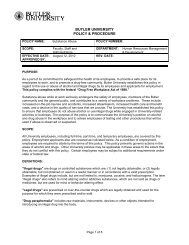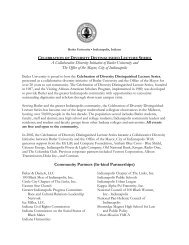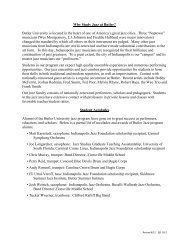Anthropology - Butler University
Anthropology - Butler University
Anthropology - Butler University
Create successful ePaper yourself
Turn your PDF publications into a flip-book with our unique Google optimized e-Paper software.
signaler or another individual. In many species, social interactions play a key role in deciding the<br />
allocation of different resources. Crayfish use aggression as a mechanism to become<br />
dominant. In crayfish, dominance structures and hierarchies are formed by dyadic interactions.<br />
Concerning invertebrates, crustaceans are considered to be ideal models of aggression and<br />
extensive work has provided an insight to the physiological and social effects on<br />
aggression. Previous research has shown that in crayfish eavesdroppers are more likely to lose a<br />
contest after watching an aggressive interaction. This suggests that crayfish are making<br />
behavioral decisions based on the observations made during an eavesdropping event. In this<br />
experiment we set up an interaction arena where two crayfish fought to establish a social<br />
hierarchy, while three crayfish observed the interaction, receiving only visual cues. The three<br />
eavesdropping crayfish were isolated in individual compartments that were built into the<br />
arena. After the first encounter, a second fight was carried out to re-establish social status, in<br />
which one eavesdropper fought the winner, the second eavesdropper fought the loser, and the<br />
third eavesdropper fought a naïve crayfish. This was done to determine if the crayfish were<br />
involved in making behavioral decisions based on observations during eavesdropping<br />
interactions. Our research shows that crayfish with information gained when they observed an<br />
aggressive interaction are more likely to win future aggressive encounters.<br />
Hormonal Consequences of Eavesdropping in the Crayfish Procambarus clarkii<br />
Brandon Quinby, Melody Palmer, Olivia Rivera & Jose Haro, Faculty Sponsor: Vanessa Quinn,<br />
Purdue North Central<br />
Aggressive behavior is speculated to an action of the amine hormone serotonin many species of<br />
crustaceans. In the crayfish Procambarus clarkii exogenous serotonin increases rates of an<br />
aggressive display, the meral spread. Serotonin injection has also been demonstrated to affect<br />
rates, intensity, and duration of aggressive encounters. In our research we examined the affect of<br />
eavesdropping on natural serotonin levels in P. clarkii. Eavesdropping occurs when an individual<br />
observes but does not take part in an aggressive encounter. If eavesdropping provides behavioral<br />
information to an individual we predicted that serotonin would also be altered. We measured<br />
serotonin levels in crayfish that were engaged in an aggressive encounter as well as individual<br />
observing the encounter. Our results show that serotonin is elevated both in the eavesdropping<br />
and interacting crayfish. Thus, eavesdropping can lead to differences in both behavioral and<br />
physiological contexts.<br />
Copperhead Snakes as a Host and the Identification of Host Cues (Kairomones) for Larvae<br />
of Ticks that Transmit Lyme Disease<br />
Benjamin Rausch, Patrick Tomko & Andrew Jajack, Faculty Sponsors: Kevin Gribbins & Jay<br />
Yoder, Wittenberg <strong>University</strong><br />
During numerous field encounters with Southern and Northern Copperheads, Agkistrodon<br />
contortrix and mokasen, in locations across eastern United States, we observed larval ticks,<br />
Ixodes scapularis, crawling and feeding on these pit vipers. Larval ticks were attached mainly<br />
between the scales of the head and cloaca, and nymph and adult ticks were rarely associated with<br />
wild Copperheads. To explore chemical cues that immature ticks may use to find snakes, we<br />
determined attraction potentials of larvae to samples of Copperhead and four other snake species'<br />
excreta (feces, uric acid), shed skins, and squalene (common snake skin lipid) in short-range
















